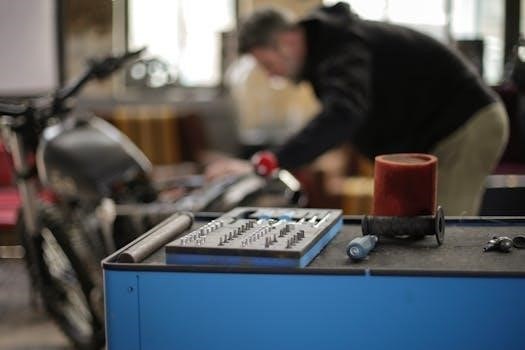totguard electric bike manual
TotGuard Electric Bike Manual⁚ A Comprehensive Guide
Welcome to the comprehensive guide for your TotGuard electric bike! This manual will provide you with the necessary information to safely operate and maintain your e-bike, ensuring enjoyable rides for years to come; Consult it regularly!
Understanding Your TotGuard E-Bike Model
Before embarking on your TotGuard e-bike adventure, it’s crucial to familiarize yourself with your specific model. TotGuard offers a diverse range of electric bikes, including the 26″ Electric Mountain Bike, 27.5″ Electric Bike, and Fat Tire eBike, each designed for unique riding experiences. Refer to the model number, often found on the bike’s frame or in your purchase documentation, to identify your exact specifications. This identification is vital as operational instructions and maintenance schedules can vary slightly across different models.
Understanding your model also helps you access the correct resources, such as specific manuals or assembly videos available on the product page. Knowing your model ensures you get the most accurate information for optimal performance and enjoyment.

Initial Setup and Assembly
Setting up your TotGuard e-bike correctly is essential. This section covers checking package contents and preparing for your first ride. Follow the steps carefully for a safe and enjoyable experience.
Checking Package Contents
Upon receiving your TotGuard electric bike, carefully inspect the package contents. Verify that all listed components are present and undamaged. Refer to the included parts list in your manual. Typically, you should find the e-bike frame, front wheel, handlebars, seat, pedals (marked L and R), battery, charger, tool kit, and user manual.
If anything is missing or damaged, contact TotGuard customer support immediately. Do not attempt to assemble or ride the e-bike until all parts are accounted for and any issues are resolved. Proper verification prevents assembly complications and ensures your safety. Also, retain all packaging material until assembly is complete.
First Ride Preparations
Before your inaugural ride, several crucial preparations are necessary. First, ensure the battery is fully charged, following the charging instructions in your manual. Next, double-check all nuts and bolts for tightness, paying special attention to the handlebar stem, seat post clamp, and wheel axles. Inflate both tires to the recommended pressure indicated on the tire sidewall.
Adjust the seat height for optimal leg extension while pedaling. Familiarize yourself with the e-bike’s controls, including the power switch, pedal assist levels, and brakes. Practice using the brakes in a safe, open area before hitting the road. Lastly, always wear a helmet for safety.

Operation and Riding Modes
This section details the operational aspects of your TotGuard e-bike. Learn about Pedal Assist System (PAS) and pure electric mode functionalities. Understand the different levels for optimized riding.
Pedal Assist System (PAS) Levels
Your TotGuard e-bike features a Pedal Assist System (PAS) that enhances your riding experience. The PAS offers multiple levels, typically ranging from 1 to 3, to provide varying degrees of motor assistance while you pedal.
Level 1 provides the least assistance, ideal for flat surfaces or when you want a more traditional cycling experience. As you increase the PAS level, the motor provides more power, making it easier to climb hills or ride against the wind. Experiment with different PAS levels to find the setting that best suits your needs and terrain. Remember to consult your specific model’s manual for precise instructions, as the process might differ slightly across various versions of TotGuard. Understanding PAS levels is crucial for efficient and enjoyable riding.
Pure Electric Mode
The TotGuard electric bike offers a pure electric mode, allowing you to ride without pedaling. This mode is activated by using the throttle, usually located on the handlebar. By twisting the throttle, you can control the speed of the e-bike, similar to a motorcycle or scooter.
Pure electric mode is perfect for situations where you want to conserve energy, tackle steep hills, or simply enjoy a effortless ride. However, it’s important to note that using pure electric mode will drain the battery faster than using pedal assist. Always be mindful of your battery level and plan your rides accordingly. Remember to consult your specific model’s manual for precise instructions, as the process might differ slightly across various versions of TotGuard. Familiarize yourself with the throttle operation for safe and controlled riding.
Maintenance and Care
Proper maintenance ensures your TotGuard e-bike’s longevity and performance. Regular checks, cleaning, and timely servicing are crucial. Pay attention to battery care and storage for optimal lifespan and performance.
Recommended Service Intervals
Regular inspection and maintenance are key to ensuring your TotGuard e-bike functions optimally, reducing wear and tear. Service intervals are guidelines; real-world conditions may necessitate adjustments. After the first 50 miles, check and adjust brake cables and spokes. Every 250-500 miles, lubricate the chain and derailleurs. Annually, inspect the battery, tires, and frame for damage or wear.
Consider professional servicing every 1000-2000 miles for a comprehensive check-up. Pay attention to any unusual noises or performance changes, addressing them promptly. Consistent maintenance ensures a safer, more enjoyable riding experience and extends your e-bike’s lifespan. Neglecting service can lead to costly repairs.
Battery Charging and Storage
Proper battery care is vital for the longevity of your TotGuard e-bike. Always use the charger provided. Connect the charger to the bike before plugging it into the AC power outlet to prevent sparking. Avoid charging in high-temperature environments or near corrosive gases, which can damage the battery.
Charge the battery fully before the first use and after each ride to maximize its lifespan. When storing the e-bike for extended periods, charge the battery to around 60% and store it in a cool, dry place. Avoid storing in extreme temperatures. Regularly check the battery’s charge level during storage and top it up as needed. This prevents deep discharge, which reduces battery life.

Troubleshooting
Encountering issues? This section addresses common problems like error codes (E10, E07) on TotGuard e-bikes. Check connections and consult this guide for solutions. Contact support if problems persist!
Common Faults (E10, E07, etc.)
Your TotGuard e-bike’s display might show error codes like E10 or E07, indicating specific problems. E10 often relates to communication issues between the controller and the display, possibly due to loose connections or a faulty wire. Check all cable connections to the display and controller, ensuring they are securely plugged in.
E07 typically signals a motor-related fault. This could stem from wiring issues, a damaged motor, or problems with the motor’s internal sensors. Inspect the motor cable for any signs of damage or disconnection. If the issue persists, seeking professional assistance is recommended.
Other error codes may appear, each corresponding to a particular system malfunction. Refer to the complete error code list in this manual or on the TotGuard website for a comprehensive understanding of the issue and possible solutions;

Safety Guidelines
Prioritize your safety! Always wear a helmet when riding; Obey all traffic laws and signals. Be mindful of pedestrians and other vehicles. Inspect your bike before each ride.
Wearing a Helmet and Following Traffic Rules
Safety is paramount when operating your TotGuard electric bike; Always wear a properly fitted helmet that meets safety standards to protect yourself from potential head injuries in case of an accident. Before each ride, ensure your helmet is securely fastened and in good condition.
Familiarize yourself with and strictly adhere to all local traffic laws and regulations. This includes obeying traffic signals, signs, and lane markings. Be aware of your surroundings and anticipate the actions of other vehicles and pedestrians. Use hand signals to indicate turns and lane changes.
Remember, riding an electric bike comes with responsibilities. By prioritizing safety and following traffic rules, you contribute to a safer environment for yourself and others.
